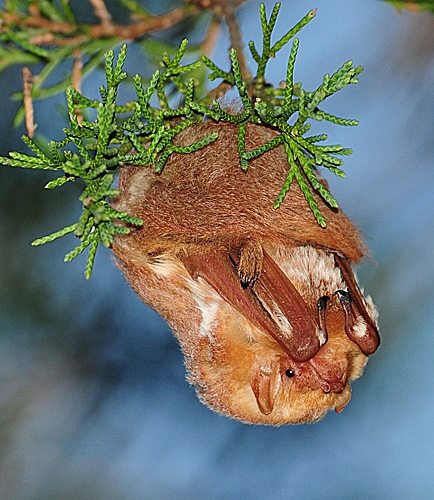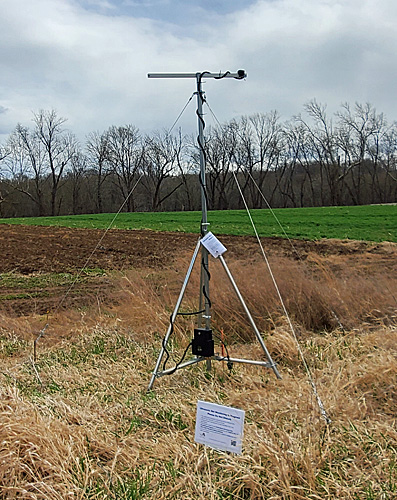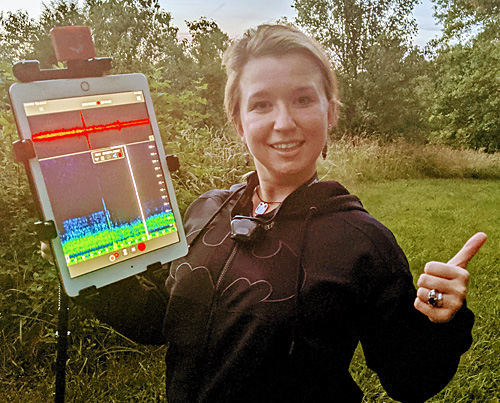Volume 28 Issue 2, Spring 2023
by Bruce Kimmel, Virginia Master Naturalist
Bats are one of the most misunderstood animals on the planet, and yet they are very important for a healthy ecosystem. Of the more than 1,400 species of bats in the world, only 45 species are found in North America. Seventeen species have been observed in Virginia, and some of those are in decline.

An Eastern Red Bat clings to a local tree. Photo by Laura McGranaghan
Bats consume lots of insects, pollinate plants, and spread plant seeds. Most bats in North America are insectivores, including all the bats that live in and visit Virginia. To put their appetite for insects into perspective, consider that a summer colony of 1,000 individual bats can consume about 4.5 million insects in a single night. The loss of bats in the United States would have an economic impact greater than $3.7 billion a year due to crop damage and the need and cost of increased use of pesticides.
Recently, several species of bats have become threatened by disease and by wind turbine-related fatalities. About 6 million bats have died from White-nose Syndrome. This disease is caused by a fungus that irritates hibernating bats, causing them to expend too much energy during non-feeding months. White-nose Syndrome mostly affects cave-hibernating bats.
In contrast, tree dwelling bats migrate over large distances during spring and fall. Wind turbine-related fatalities have had an impact on the numbers of these types of bats. Some migrating bats appear to be attracted to wind turbines, perhaps because they perceive the structures as big trees.
The lack of information about bats and the precipitous decline of some species caused the U.S. Geological Survey to launch the North American Bat Monitoring Project (NABat) in 2015. The NABat study’s design divides North America into more than 133,000 grid regions for monitoring. Bats can be identified from recordings of their ultrasonic echolocation calls, which they use to navigate and hunt for food. By monitoring over several years and across many grids, the study should establish the presence, absence, and migration of bats in regions throughout North America.

Master naturalists recorded bats’ echolocation calls via this stationary monitoring rig at Lost Corner Farm and 12 others at other Loudoun locations. Photo by Bruce Kimmel
In collaboration with the NABat project, the Virginia Master Naturalists (VMN) Banshee Reeks Chapter has launched a project to establish which bats visit and utilize Loudoun County. In 2022, four NABat grids located in Loudoun County were acoustically monitored for bats from April through November with 13 recorders. More than 500,000 bat call recordings were made during this monitoring period.
Analysis of the recordings showed that at least nine species of bats utilize Loudoun County: Big Brown, Little Brown, Hoary, Silver-haired, Eastern Red, Northern Long-eared, Tri-colored, Mexican Free-tailed, and Evening Bats.
Some of the county’s protected areas, like JK Black Oak Wildlife Sanctuary and Morven Park, were hot spots for bat activity, with more than 140,000 recordings collected at these two locations alone. JK Black Oak was also a hot spot for species diversity, as all nine species were observed in the sanctuary.

Susan Sims checks recording results on a handheld bat monitor. Photo courtesy of Susan Sims
The most fascinating recordings were of the Northern Long-eared Bat, which was recently placed on the endangered species list because of declines resulting from White-nose Syndrome. It is exciting to see that northern Loudoun County provides a home for this rare and endangered bat species.
Interestingly, the Mexican Free-tailed Bat is considered a southern species, so the observation of this species in Loudoun County is somewhat surprising. Further study will be required to confirm these observations. If Free-tailed Bats are in the county, it could suggest a correlation to the warming climate.
What’s next for the Loudoun County bat monitoring project? In 2023 the same 13 sites will continue to be monitored, and we hope to expand to more monitoring locations. The project will continue over the next decade and beyond so that we can monitor the health of the local bat population and make important contributions to the NABat project to inform future conservation policy.

